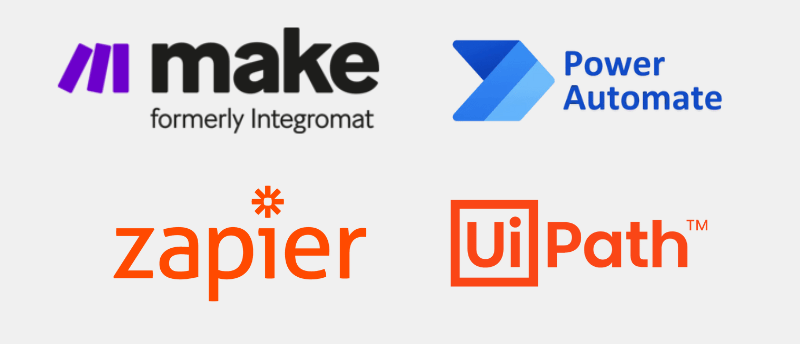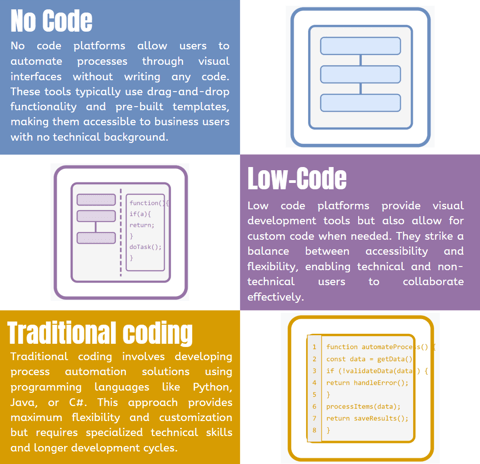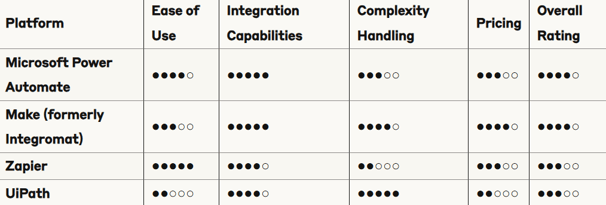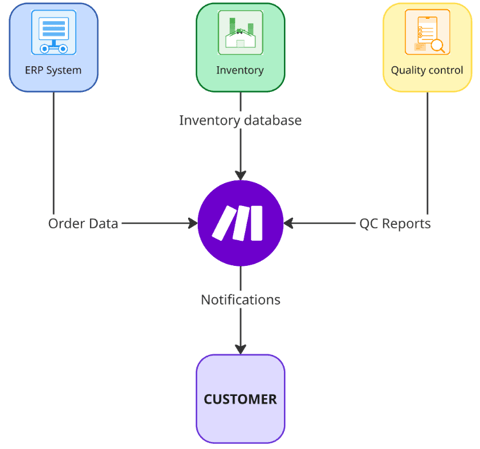Low-Code Automation Platforms for SMEs
Low-code automation platforms are revolutionizing how SMEs approach digital transformation, offering accessible solutions without extensive coding expertise. This analysis compares Power Automate, Make, Zapier, and UiPath, highlighting their strengths, limitations, and ideal use cases to help IT professionals and process developers select the right platform for their specific business needs.
SMEPROCESS AUTOMATIONMAKE.COMZAPIER
Dávid Pálfalvi
5/15/20258 min read


In today's fast-paced business environment, SMEs face mounting pressure to digitalize operations while contending with limited IT resources and expertise. This challenge is particularly acute in Hungary and Central Europe, where the technical talent gap continues to widen. Low-code automation platforms have emerged as a powerful solution, enabling businesses to implement sophisticated automation without extensive development resources. According to recent market projections, the global low-code development platform market is expected to reach $187 billion by 2030, growing at a CAGR of 31.1%. This explosive growth reflects the urgent need for businesses to accelerate their digital transformation initiatives while navigating resource constraints.
Understanding Low-Code Automation Fundamentals
Before diving into platform comparisons, it's essential to understand what distinguishes low-code automation platforms from traditional development approaches. Low-code platforms provide visual development environments where users can create applications and automation workflows through graphical user interfaces rather than writing extensive code.
These platforms typically offer:
Drag-and-drop functionality for workflow creation
Pre-built templates and connectors to popular services
Visual process modeling tools - Built-in testing and deployment capabilities
Cross-platform compatibility
The primary advantage for SMEs is the dramatic reduction in both development time and technical expertise required. Processes that once took months to automate can now be implemented in days or even hours, with much of the work handled by business users rather than dedicated developers.
Low-Code vs. No-Code: Understanding the Difference
While often mentioned together, low-code and no-code platforms serve slightly different purposes:
Low-code platforms require minimal coding knowledge but offer deeper customization options and are typically more powerful for complex automation scenarios.
No-code platforms require zero coding knowledge but may have more limitations for highly specialized or complex processes. Many platforms now offer both capabilities, allowing businesses to start with simple no-code automation and progress to more sophisticated low-code solutions as their needs evolve.


Comparison of Leading Low-Code Automation Platforms
Let's examine the four major platforms that dominate the low-code automation landscape, each with distinct strengths and ideal use cases.
Microsoft Power Automate: The Enterprise Integration Specialist
Power Automate (formerly Microsoft Flow) has become a cornerstone of Microsoft's Power Platform, offering tight integration with the Microsoft ecosystem.
Key Strengths:
Seamless integration with Microsoft 365 applications (SharePoint, Teams, Outlook)
Robust security and compliance features meeting enterprise standards
AI Builder capabilities for integrating AI models into workflows
Both cloud flows and desktop automation capabilities (RPA) - Strong data policy and governance features
Limitations:
Steeper learning curve compared to Zapier
Most valuable when already invested in Microsoft ecosystem
Premium connectors require additional licensing
Can become expensive for organizations with many users
Ideal Use Cases:
Document approval workflows in Microsoft-centric organizations
Data processing between Excel, SharePoint, and other Microsoft applications
Advanced automation requiring both cloud connectivity and desktop automation
Enterprise environments with strict security and compliance requirements
Pricing Model: Microsoft Power Automate starts at $15/user/month (Premium plan), $150/bot/month (Process plan), and $215/bot/month (Hosted Process), with a free trial and additional enterprise add-ons available.
Make.com: The Visual Workflow Champion
Make has earned a reputation for its exceptionally intuitive visual interface combined with surprising technical depth.
Key Strengths:
Outstanding visual workflow designer with the most intuitive interface
Exceptional value for price, especially for smaller businesses
Flexible execution scheduling options
Strong data transformation capabilities
Robust error handling and troubleshooting tools
Limitations:
Smaller connector library compared to Zapier
Less name recognition in enterprise environments
Limited desktop automation capabilities
Some advanced features require technical knowledge
Ideal Use Cases:
Complex multi-step workflows requiring sophisticated data transformation
Marketing automation across multiple platforms
Businesses prioritizing value and flexibility over enterprise features
Organizations needing detailed monitoring and error handling
Pricing Model: Make.com offers a free plan with 1,000 operations per month, and paid plans start at $9/month (Core), $16/month (Pro), and $29/month per user (Teams), with higher tiers offering more operations and features
Need help implementing Make.com in your business? Book a quick consultation with our experts to discuss your specific needs.
Zapier: The Connectivity Leader
Zapier remains the most accessible entry point for simple automation with the widest range of application integrations.
Key Strengths:
Largest library of app integrations (4,000+ apps) - Most user-friendly for beginners
Excellent documentation and templates
Quick setup for simple automation workflows
No technical knowledge required for basic use
Limitations:
Limited complex workflow capabilities
Less flexible execution scheduling than competitors
Higher price points for high-volume operations
No desktop automation capabilities
Limited data transformation features
Ideal Use Cases:
Simple trigger-action workflows between common business applications
Small businesses and startups with limited technical resources
Marketing teams needing quick integration between platforms
Quick automation prototyping before investing in more complex systems
Pricing Model: Zapier has a free plan with 100 tasks per month, while paid plans start at $19.99–$39.99/month (Starter), $49–$3,389/month (Professional), $299.99–$3,499/month (Team), and $599–$3,599/month (Company), with higher plans allowing more tasks and features.


UiPath: The RPA Powerhouse
UiPath has evolved from a pure RPA (Robotic Process Automation) tool to include low-code capabilities, making it a powerful choice for certain scenarios.
Key Strengths:
Industry-leading desktop and application automation
Advanced document processing with AI capabilities
Enterprise-grade security and governance
Sophisticated workflow orchestration
Comprehensive automation lifecycle management
Limitations:
Higher implementation complexity than other platforms
Requires more specialized knowledge
Significant investment for full capabilities
Primarily designed for larger enterprises
Steeper learning curve for non-technical users
Ideal Use Cases:
Process automation involving legacy systems without APIs
Document processing workflows requiring intelligent data extraction
Enterprise environments with complex automation requirements
Organizations looking to scale automation across departments
Processes requiring unattended robot execution
Pricing Model: Enterprise pricing model varies by deployment; starter plans from €420/year per attended robot.
Strategic Selection Criteria for Hungarian and Eastern European SMEs
Businesses in Hungary and Eastern Europe face unique considerations when selecting a low-code automation platform. Regional factors that should influence your decision include:
Regional Integration Requirements
Many Hungarian businesses rely on region-specific applications and services that may not have global recognition. When evaluating platforms, consider:
Local Software Support: Does the platform integrate with popular local accounting systems like Navision, SAP Business One, or IXON?
Language Support: Does the platform support Hungarian/local language interfaces, both for development and end-user experiences?
Regional Compliance: How well does the platform handle EU regulations like GDPR and local Hungarian data protection requirements?
Resource Considerations for Regional SMEs
SMEs in the region typically operate with tighter IT budgets and smaller technical teams than their Western European counterparts:
Total Cost of Ownership: Beyond subscription fees, consider implementation, training, and maintenance costs
Available Talent Pool: Assess the availability of specialists in your region for each platform
Training Requirements: Evaluate the learning curve against your team's current capabilities
Real-World Implementation: Hungarian Manufacturing Case Study
A medium-sized manufacturing company in Budapest implemented Make (formerly Integromat) to resolve disconnects between their production planning system, inventory management, and customer communication channels.
Challenge: Manual data transfer between systems was causing delays, errors, and customer dissatisfaction. With a limited IT team of just two people and budget constraints, traditional integration development was not feasible.
Solution: The company implemented automated workflows using Make.com that:
Connected their legacy ERP system to their modern inventory management platform
Automated customer updates based on production status changes
Integrated quality control data with production planning
Generated and distributed automated management reports
Results:
87% reduction in manual data entry
Customer response time improved from 24 hours to under 2 hours
Order processing errors decreased by 93% - ROI achieved within 3.5 months
Implementation completed by existing staff with minimal training The company's Operations Director noted:
"We evaluated several platforms, but Make provided the right balance of capability and accessibility for our team. We've since expanded our automation to include 27 critical workflows across the organization.


Implementation Roadmap for Low-Code Automation Success
Based on our experience guiding Hungarian and Eastern European businesses through automation journeys, we recommend this implementation approach:
1. Strategic Process Assessment
Before selecting a platform, document your most critical processes for automation: - Map current manual workflows highlighting pain points and inefficiencies - Identify processes with clear ROI potential (high volume, error-prone, time-sensitive) - Catalog existing systems that will need integration - Quantify current costs of manual processes (time, errors, opportunity costs)
2. Platform Selection Based on Use Case Priority
Different platforms excel at different types of automation:
For document-heavy processes (contracts, invoices): Consider UiPath
For Microsoft-centric environments: Power Automate is typically most efficient
For marketing and customer journey automation: Zapier often provides quickest value
For complex data transformations between systems: Make offers exceptional capability
3. Pilot Implementation Approach
Begin with a controlled implementation to validate your approach:
Select a high-impact but contained process for your first automation
Implement in parallel with existing manual processes
Measure results against clear KPIs
Gather user feedback and refine
Document lessons learned before scaling
4. Governance and Scaling Framework
As you expand your automation footprint: - Establish naming conventions and documentation standards - Create a central repository of automation workflows - Implement testing protocols for new automations - Develop monitoring and alert systems for failures - Create a center of excellence with automation champions
ROI Comparison Across Platforms
When calculating potential ROI, consider these platform-specific factors:
Power Automate:
Highest ROI for Microsoft-centric organizations
License costs can be minimized by bundling with existing Microsoft subscriptions
Desktop flow capabilities offer automation potential for legacy applications
Typical ROI timeframe: 4-6 months for organizations already on Microsoft 365
Make:
Typically offers fastest ROI for SMEs due to lower entry costs
Flexible operation-based pricing scales efficiently with actual usage
Strong data transformation capabilities reduce need for middleware
Typical ROI timeframe: 2-4 months for most SMEs
Zapier:
Fastest implementation timeline reduces upfront costs
Simple automations can be deployed without technical resources
Ideal for marketing and sales automation with quick returns
Typical ROI timeframe: 1-3 months for simple use cases
UiPath:
Highest implementation costs but also highest potential returns for complex scenarios
Best ROI for automating high-volume, repetitive tasks involving legacy systems
Advanced document processing capabilities deliver significant ROI for document-heavy industries
Typical ROI timeframe: 6-12 months for enterprise implementations
Future Trends in Low-Code Automation for European SMEs
Looking ahead, several emerging trends will shape the low-code automation landscape for Hungarian and European businesses:
AI Integration: All major platforms are rapidly incorporating AI capabilities, enabling more intelligent decision-making within automated workflows. Power Automate and UiPath currently lead in this area.
Vertical-Specific Solutions: Expect to see more industry-specific templates and connectors tailored to European regional requirements, particularly in regulated industries like healthcare and finance. Convergence with Process Mining: Platforms will increasingly incorporate process discovery capabilities to identify automation opportunities automatically.
Hybrid Workforce Orchestration: Low-code platforms will evolve to better coordinate work between human employees and digital workers, creating seamless handoffs in complex processes.
Edge Automation: As IoT adoption increases in European manufacturing, low-code platforms will expand capabilities to integrate with edge devices and systems.
Key Takeaways for Hungarian and Eastern European SMEs
Start with clear objectives: Define what success looks like before selecting a platform
Match platform to primary use case: Different tools excel in different scenarios
Consider total ecosystem: Evaluate your existing technology investments when choosing a platform
Begin small but plan for scale: Start with pilot projects that demonstrate quick wins
Build internal capability: Invest in training to reduce dependency on external consultants -
Measure and communicate results: Track concrete metrics to demonstrate ROI and secure organizational buy-in
Conclusion: Making the Right Choice for Your Business
The low-code automation landscape offers unprecedented opportunities for Hungarian and Eastern European SMEs to accelerate digital transformation without massive IT investments. The right platform choice depends on your specific business context, existing systems, and automation priorities. Power Automate makes sense for Microsoft-centric organizations with deeper resources. Make offers the best balance of capability and accessibility for most SMEs. Zapier provides the quickest path to simple automations across many applications. UiPath delivers the most comprehensive solution for complex enterprise environments. Regardless of which platform you select, the most critical success factor is having a clear automation strategy aligned with business objectives. With the right approach, even small companies can achieve automation results that rival those of much larger enterprises, creating significant competitive advantages in increasingly digital markets.
Ready to transform your business operations? Fill out our quick contact form to get started, or schedule a 15-minute consultation directly with our implementation specialists.
Innovate with Intellect.
Revolutionize workflows with cutting-edge AI solutions.
About Us
2024-2025 Innovectus - All rights reserved.
